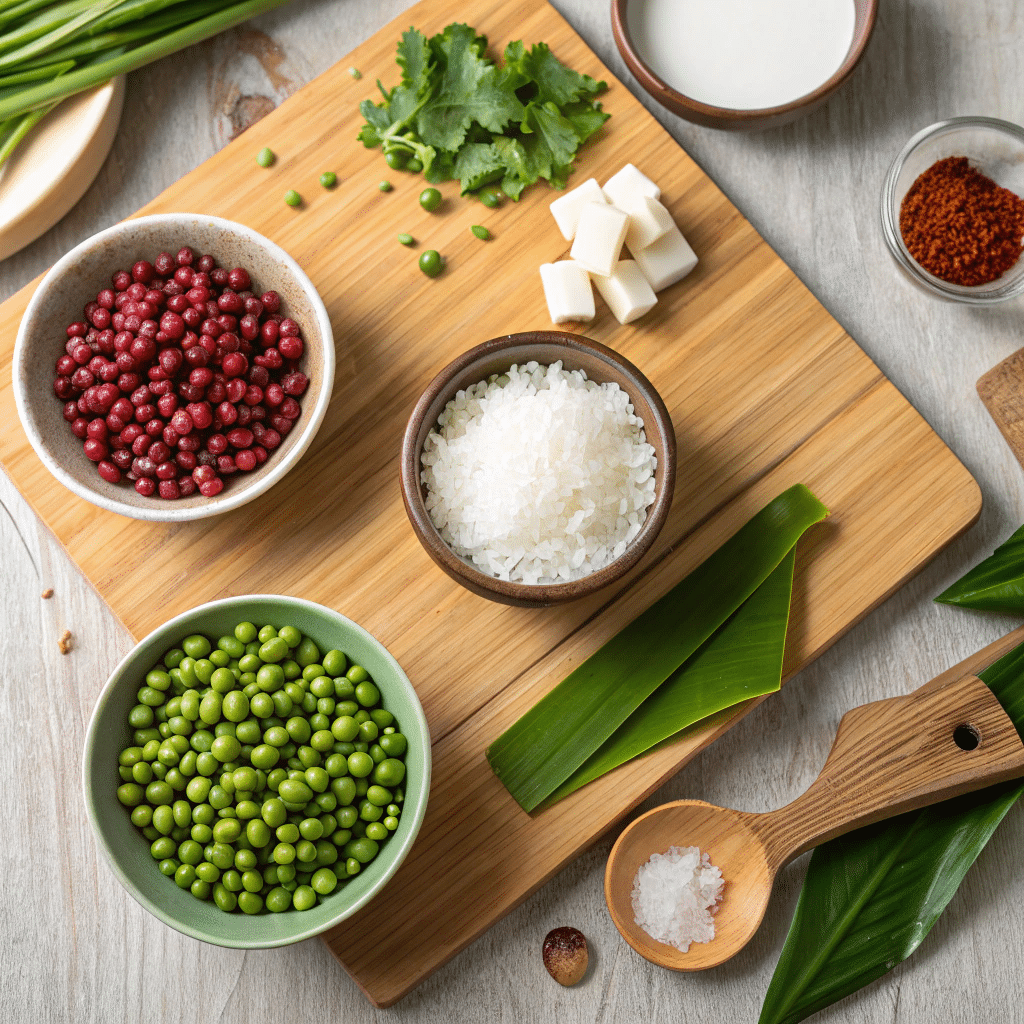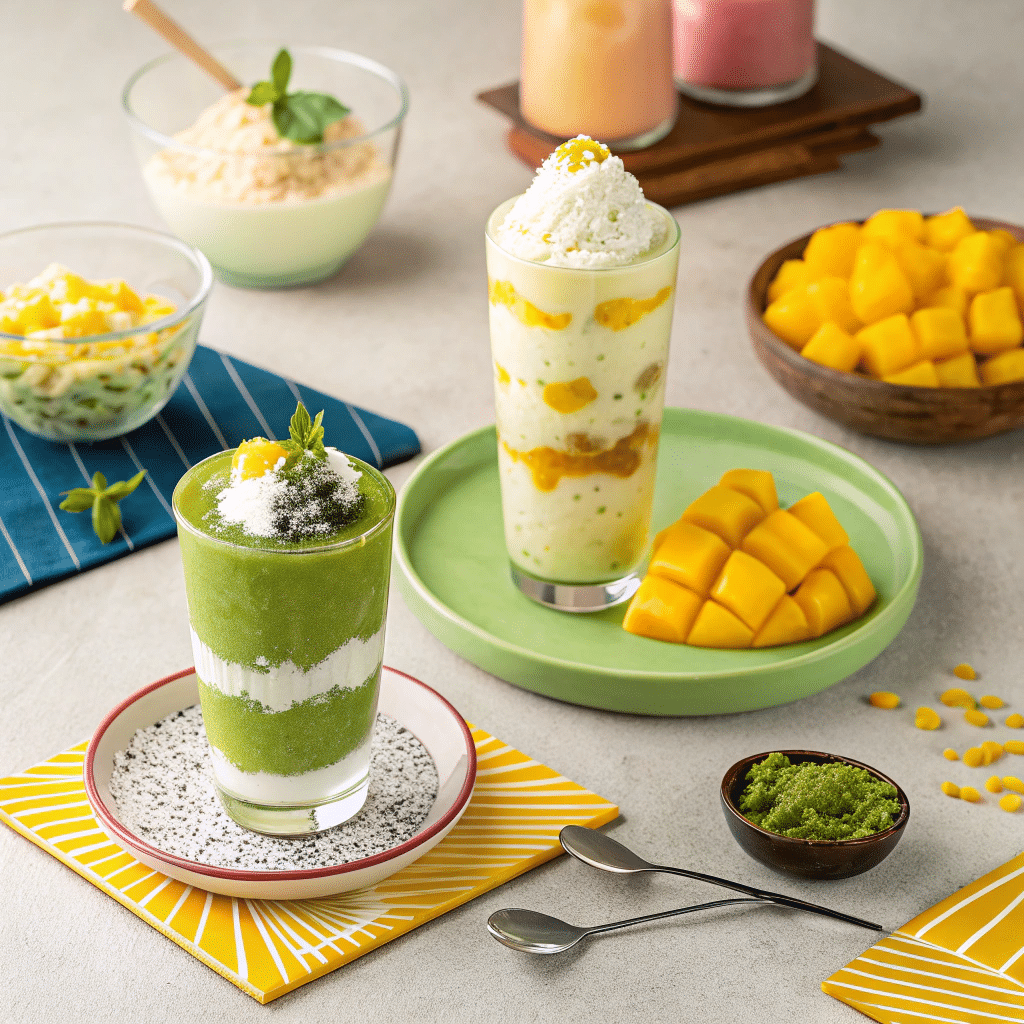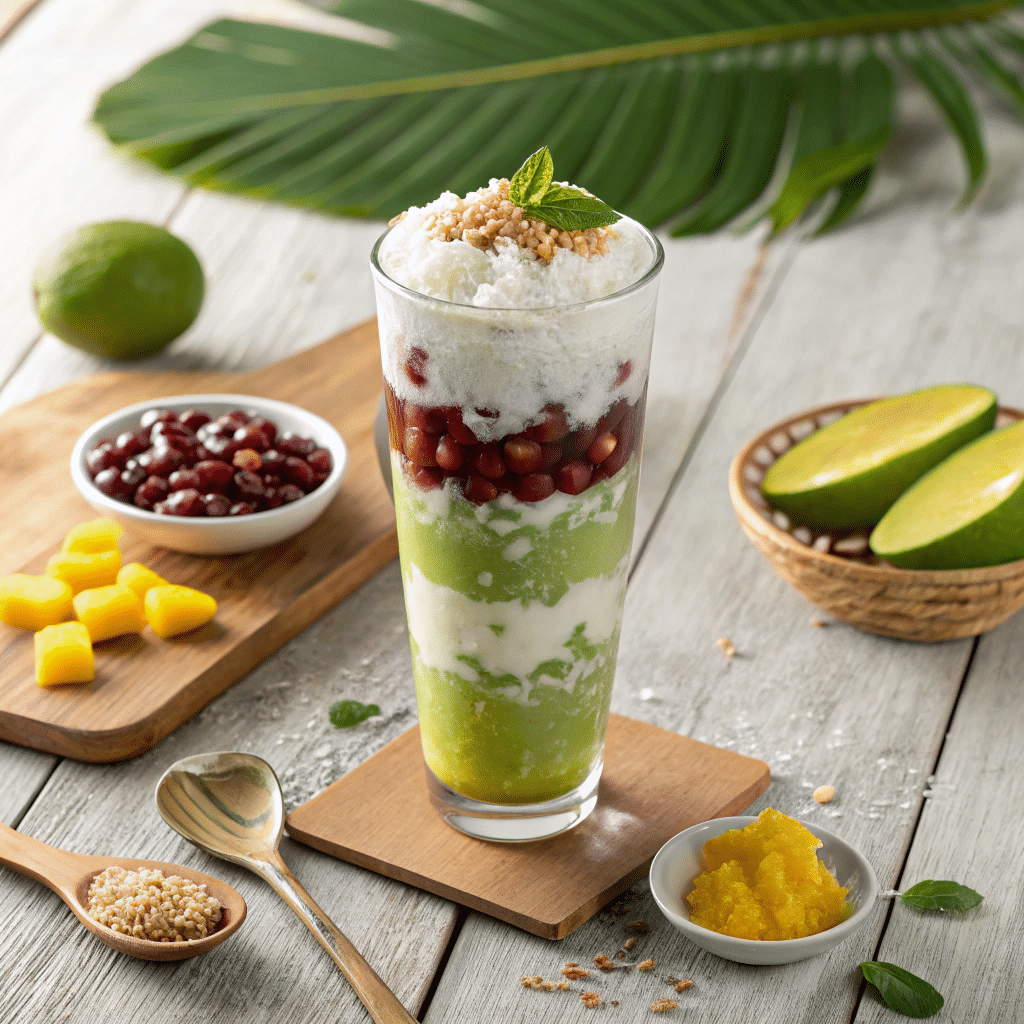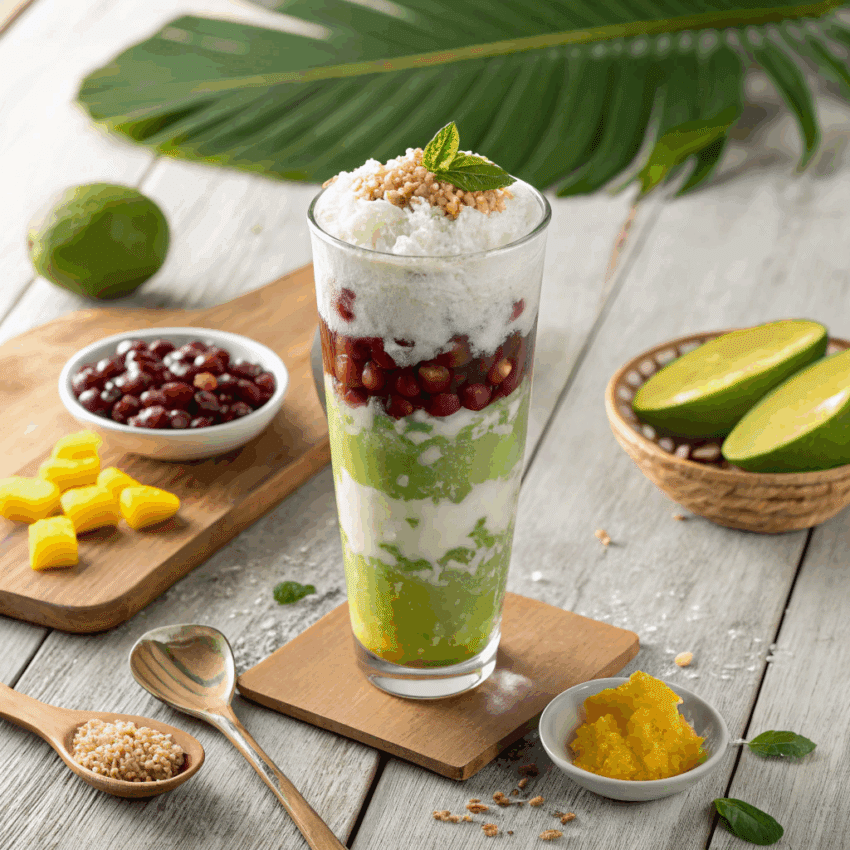Vietnamese cuisine is filled with refreshing sweets, and one of the most beloved is Che Ba Mau—also called the Vietnamese three-color dessert. If you’ve ever wanted to dive into Vietnamese desserts that balance texture, flavor, and eye-catching beauty, this sweet soup is a perfect place to start.
Che Ba Mau literally means “three colors”, and that’s exactly what you get: three layers of deliciousness topped with crushed ice and a drizzle of creamy coconut sauce. It’s cooling, vibrant, and one of those Asian desserts that feels like both a drink and a snack at the same time.
What is Che Ba Mau?
Che Ba Mau is a layered Vietnamese sweet rice dessert served in a tall glass. At its core, it’s made of:
- Sweetened mung bean paste
- Red beans or adzuki beans
- Green pandan jelly strips (often called the Vietnamese green dessert layer)
All of this is finished with crushed ice, grass jelly (optional), and a rich coconut cream topping. The result? A refreshing Vietnamese dessert easy enough for home cooks but still impressive enough for any gathering.
Think of it as Vietnam’s answer to a sundae—only lighter, fresher, and perfect for hot days.
Ingredients You’ll Need

To make an authentic Che Ba Mau Vietnamese dessert, gather the following:
For the Bean Layers:
- 1 cup dried adzuki beans or red kidney beans (soaked overnight)
- 1 cup split mung beans (soaked for at least 2 hours)
- ½ cup sugar (divided for both beans)
- A pinch of salt
For the Pandan Jelly:
- ½ cup mung bean starch (or agar powder)
- 2 cups water
- 1 tsp pandan extract (for that signature green color and fragrance)
- 2 tbsp sugar
For the Coconut Sauce:
- 1 can (400ml) coconut milk
- 2 tbsp sugar
- 1 tbsp cornstarch mixed with 2 tbsp water (to thicken)
- Pinch of salt
For Serving:
- Crushed ice
- Optional: grass jelly cubes or sweet corn pudding for extra flavor
Step-by-Step Instructions
1. Cook the Red Beans
Simmer the soaked red beans in fresh water until soft (about 45–60 minutes). Sweeten with sugar and a pinch of salt. Let it cool completely.
2. Cook the Mung Beans
Steam the soaked mung beans until tender. Mash them into a paste, sweeten lightly with sugar, and let cool. This layer gives a creamy base that balances the chewy and crunchy textures.
3. Make the Pandan Jelly
In a saucepan, combine mung bean starch, water, pandan extract, and sugar. Cook until thick and smooth. Spread the mixture into a shallow tray, let it set, and then cut into thin strips. This is your Vietnamese green dessert layer.
4. Prepare the Coconut Sauce
Heat coconut milk with sugar and salt. Add the cornstarch slurry and stir until slightly thickened. This creamy topping is what makes Che Ba Mau irresistible.
5. Assemble the Che Ba Mau
- In a tall glass, add a layer of red beans.
- Top with mung bean paste.
- Add the pandan jelly strips.
- Toss in crushed ice and optional grass jelly cubes.
- Pour coconut sauce generously over the top.
That’s it—your Vietnamese dessert recipe is ready to enjoy.
Why You’ll Love Che Ba Mau
Che Ba Mau is more than just a Vietnamese dessert easy enough for a weeknight treat—it’s an experience. The cold ice, the earthy beans, the fragrant pandan, and the luscious coconut all play together beautifully.
When I first tried this dessert in Vietnam, it reminded me of a layered trifle, but with brighter flavors. It’s comforting, refreshing, and endlessly customizable. Add corn, taro, or even durian if you’re feeling adventurous.
Tips for the Perfect Che Ba Mau
- Soak your beans overnight. This speeds up cooking and gives them a creamier texture.
- Don’t oversweeten. Each layer should be subtly sweet so the coconut cream can shine.
- Use crushed ice, not cubes. It blends better into the dessert, giving every spoonful a refreshing chill.
- Experiment with add-ins. Sweet corn pudding, taro chunks, or even jackfruit can elevate this classic.
Variations and Fusion Ideas

Che Ba Mau is already a masterpiece, but if you’re like me and love experimenting, here are some twists:
- Fusion Food Fun: Swap pandan jelly for matcha jelly for a Japanese-Vietnamese crossover.
- Tropical Vibes: Add chunks of ripe mango for a fruitier take.
- Extra Creamy: Mix condensed milk into the coconut topping for a thicker, sweeter finish.
This versatility makes Che Ba Mau one of the best easy Vietnamese recipes to adapt at home.
Health Benefits of Che Ba Mau
While it feels indulgent, this Vietnamese sweet soup can actually be a nutritious treat.
- Mung beans are high in protein and fiber.
- Adzuki beans are packed with antioxidants.
- Pandan is believed to have calming properties.
- Coconut milk provides healthy fats (in moderation, of course).
So yes—it’s dessert, but one you don’t have to feel guilty about.
Final Thoughts
Che Ba Mau proves that Vietnamese desserts are more than just sweet—they’re playful, textural, and deeply satisfying. Whether you’re exploring Vietnamese cuisine for the first time or you’re a longtime fan of Viet food, this Che Ba Mau Vietnamese dessert is a must-try.
So grab your beans, crush some ice, and whip up this colorful delight. Dessert has never looked (or tasted) this good.

Vietnamese Che Ba Mau (Three-Color Dessert)
Ingredients
Method
- Drain the soaked beans. Simmer in fresh water for 45–60 minutes until tender. Stir in sugar and a pinch of salt. Let cool.
- Steam the soaked mung beans until soft. Mash them lightly with a spoon and mix with sugar. Set aside.
- In a small pot, mix mung bean starch, pandan extract, sugar, and water. Stir over medium heat until thick and smooth. Spread into a tray, let set, then cut into thin strips.
- In a saucepan, heat coconut milk with sugar and salt. Add the cornstarch slurry and stir until slightly thickened. Remove from heat.
- In a tall glass, layer red beans, mung bean paste, and pandan jelly. Add crushed ice and optional toppings like grass jelly. Pour coconut sauce on top. Serve cold with a spoon.
Notes
- You can replace pandan jelly with agar jelly if you can’t find pandan extract.
- Sweetness levels can be adjusted to your taste.
- Best eaten right after assembling, so the ice doesn’t melt too much.
Frequently Asked Questions
1. Is Che Ba Mau served hot or cold?
Always cold! Crushed ice is essential for its refreshing flavor.
2. Can I use canned beans instead of dried?
Yes, you can. Just rinse them well and simmer with sugar until sweetened.
3. What does Che Ba Mau taste like?
It’s mildly sweet, creamy, and layered with different textures—soft beans, chewy jelly, and smooth coconut.
4. Can I make it ahead of time?
Yes. Prepare the beans, jelly, and coconut sauce separately. Store them in the fridge, then assemble when ready to serve.
5. Is this dessert kid-friendly?
Absolutely! Kids love the colors and sweetness, though you might want to skip the grass jelly if they’re picky eaters.

